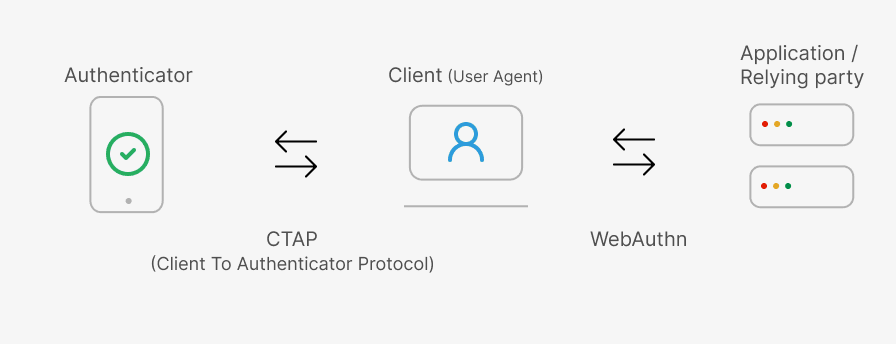Decoding Passkeys: The Future of Seamless Web3 Authentication

4 mins
Last Edited: Jan 02, 2024
Share
Decoding Passkeys: The Future of Seamless Web3 Authentication
Step into a new era of Web3 authentication! Passkeys that brings a new dimension to passwordless authentication, prioritizing both security and user experience (UX)
Key Management
Intermediary
Ever tripped over a password or gotten lost in a sea of seed phrases? Web2 and Web3 both have their authentication headaches. But what if there was a better way? That's where Passkey comes in. This innovative technology promises not only enhanced security but also a smoother user experience. Let's explore its core features, benefits, and challenges to see how Passkeys could reshape Web3 authentication. Before exploring Passkey's potential, let's unpack its foundation-
No Web3 wallets are Perfect ! 😕
 Traditional Web3 wallets open the door to a decentralised world… But they have their own limitations !!
Traditional Web3 wallets open the door to a decentralised world… But they have their own limitations !!
Challenges of Traditional Web3 Wallets
Complex user experience: Setting up and managing a traditional wallet can be intimidating for new or users unfamiliar with blockchain technology. The complexity of the private key, seed phrase and blockchain interactions may discourage newcomers from fully engaging with Web3.
Lack of recovery options: Traditional Web3 wallets often depend solely on seed phrases for wallet recovery. If users lose their seed phrases, their assets are locked forever.
Risk of scams: Although Web3 wallets prioritise security, the rise of scams can be a risk for new and inexperienced users.
Theft of Private Keys/Seed Phrases: Private keys or seed phrases can be stolen or phished through increasingly sophisticated and diverse methods. Once compromised, these keys grant attackers complete control over the associated wallets.
This is where passkeys become handy! 🗝️
What are Passkeys?
Passkeys are an authentication method designed to replace traditional passwords by leveraging biometrics. Developed by the FIDO Alliance and supported by major tech companies such as Apple, Google, Meta, and Microsoft, passkeys are implemented through the WebAuthn. WebAuthn is a crucial component that supports the functionality of passkeys. Together, passkeys and WebAuthn create a passwordless login experience for the user.

How do users use Passkeys?
The sign-in process with passkeys allows users to use facial recognition, fingerprint scanning, or a personal identification number (PIN, the same one used for unlocking the device)
Passkeys are a more secure way to log in compared to passwords. Since, they are generated and managed exclusively on users’ devices, making it difficult for hackers to compromise user login credentials. This not only enhances security but also improves the overall user experience.

Benefits of Passkeys in Web3 Authentication
Authentication: Passkeys eliminate the need for complex passwords and seed phrases, enabling users to authenticate with a simple fingerprint scan or facial recognition.
Stronger Security: Passkeys utilise biometric authentication factors, adding an extra layer of security to user accounts.
Reduced Phishing Attacks: Unlike passwords, which can be stolen when entered on phishing websites, passkeys' device-based authentication makes them immune to such attacks. Think of it like a fingerprint scanner for your crypto – no more typos or leaked passwords can grant access to malicious websites. This significantly reduces the risk of losing your precious assets to scams and empowers you to confidently navigate the Web3 world.
Multi-device Support: Passkeys operate seamlessly across various devices, including smartphones, tablets, and laptops, ensuring consistent UX.

Despite having great potential to change the way we use Web3 wallets today. There are a few challenges with Passkeys
Challenges in Passkey Implementation
Device Dependence: While Passkeys offer enhanced security by residing directly on users' devices, this dependency also raises concerns about backup and recovery. Apple users enjoy secure iCloud Keychain backups, while Android and Windows users face fragmented options like Google Password Manager.
Cost Considerations: On-chain verification and signatures associated with Passkey transactions may incur higher fees compared to traditional wallets, potentially impacting user adoption.
Self-Custody Concerns: The reliance on existing logins like Apple or Google for Passkey activation has sparked debate about whether true self-custody of crypto assets is fully realised.
Server-Side Vulnerability: Passkeys remain tied to the specific application or server they're associated with. If the server goes down, the relevant Passkey becomes inaccessible, even though the device itself might still be functional.
Standardisation Gap: The current lack of standardised protocols across device ecosystems creates walled gardens, hindering Web3's vision of universal accessibility. Until cross-brand authentication bridges these gaps, the full potential of Passkeys will remain limited.
Cross-Device Friction: Switching between devices like iPhone and Android can be problematic with Passkeys, as seamless logins across ecosystems aren't yet a reality.
Pioneering Passkey Wallet Projects:
Banana SDK, Clave and Silence Laboratories are few examples of passkey wallets.
Clave and Banana SDK uses special contracts on compatible blockchains (like Ethereum) to process Passkey signatures. While this is cool, it can be expensive (think high transaction fees). For example, one signature might cost as much as a fancy coffee!
Conclusion: Shaping a Secure and User-Centric Web3 Future
Passkeys represent a promising advancement in Web3 authentication. No more forgotten seed phrases or phishing scams – passkeys offer seamless biometric authentication and robust security across devices. While high transaction costs pose a challenge, protocols are exploring solutions like dedicated 'sidechains' or 'self-chains' for verifying Passkeys, potentially at the cost of reduced compatibility with other blockchains. Continued development holds immense potential to unlock the full power of passkeys for a user-centric and secure Web3 ecosystem.
References
- https://www.theblock.co/post/261435/revolutionizing-the-future-of-web3-in-depth-insights-into-passkey-wallets
- https://www.openfort.xyz/blog/passkeys-and-account-abstraction
- https://medium.com/alphawallet/exploring-passkeys-their-relevance-in-the-web3-space-fcd877dcbd4
- https://talk.nervos.org/t/a-translation-of-revolutionizing-the-future-of-web3-in-depth-insights-into-passkey-wallets-and-their-emerging-role/7511
- https://web.dev/articles/passkey-google-ux
- https://www.passkeys.io/who-supports-passkeys
🔑 Key Takeaway
Passkeys, powered by biometrics, offer a secure and user-friendly alternative to traditional web3 wallets. While challenges like cost and device dependence remain, their potential to revolutionize user experience and security in Web3 is undeniable.